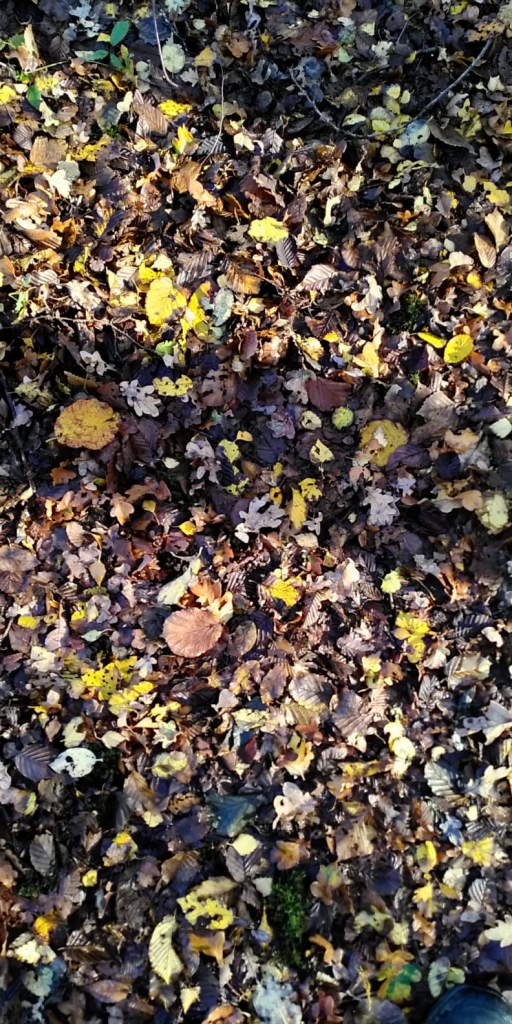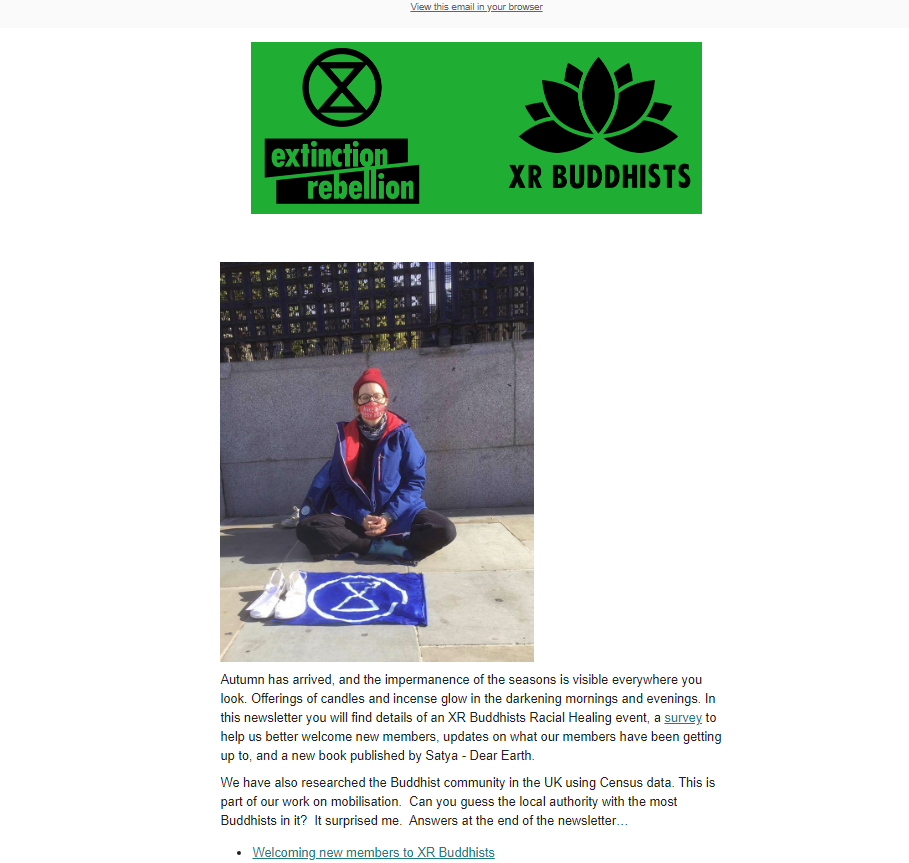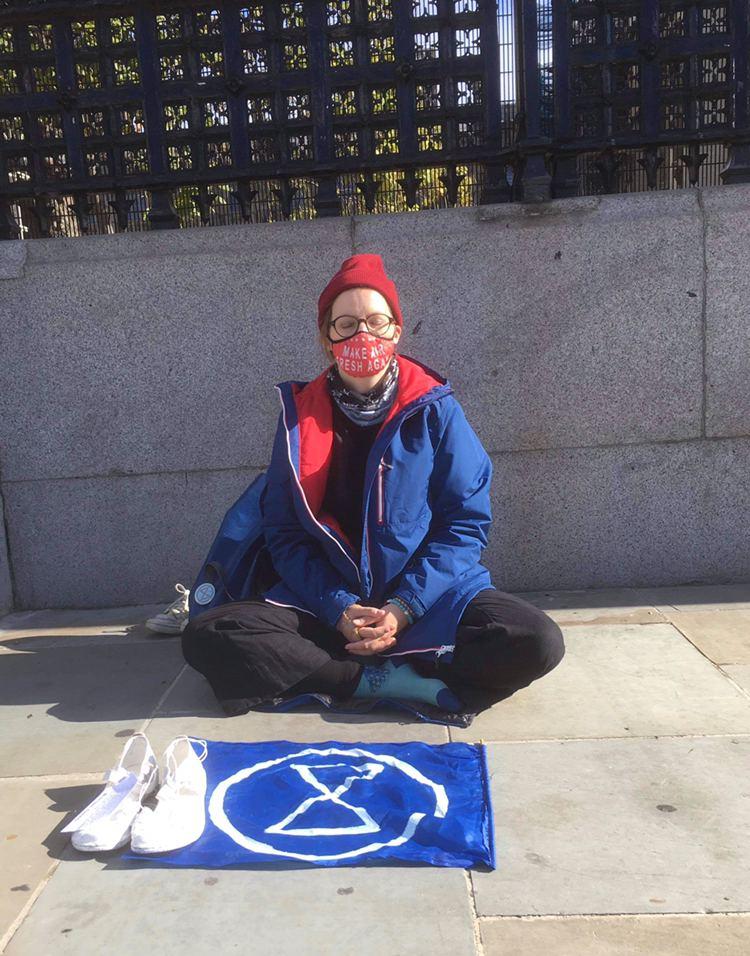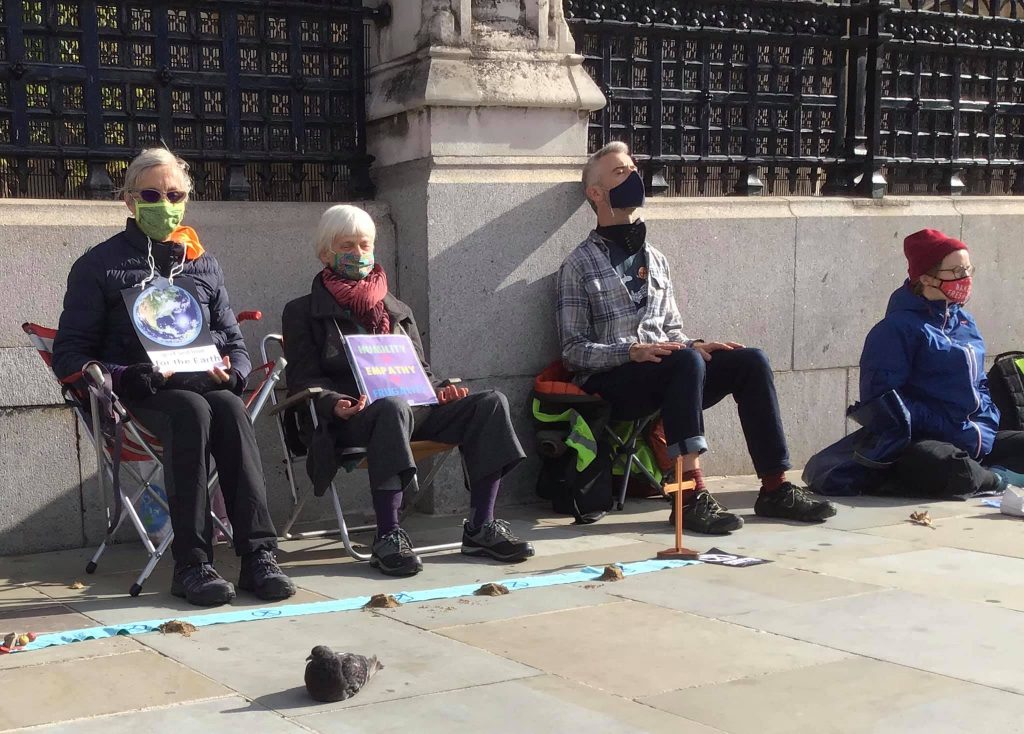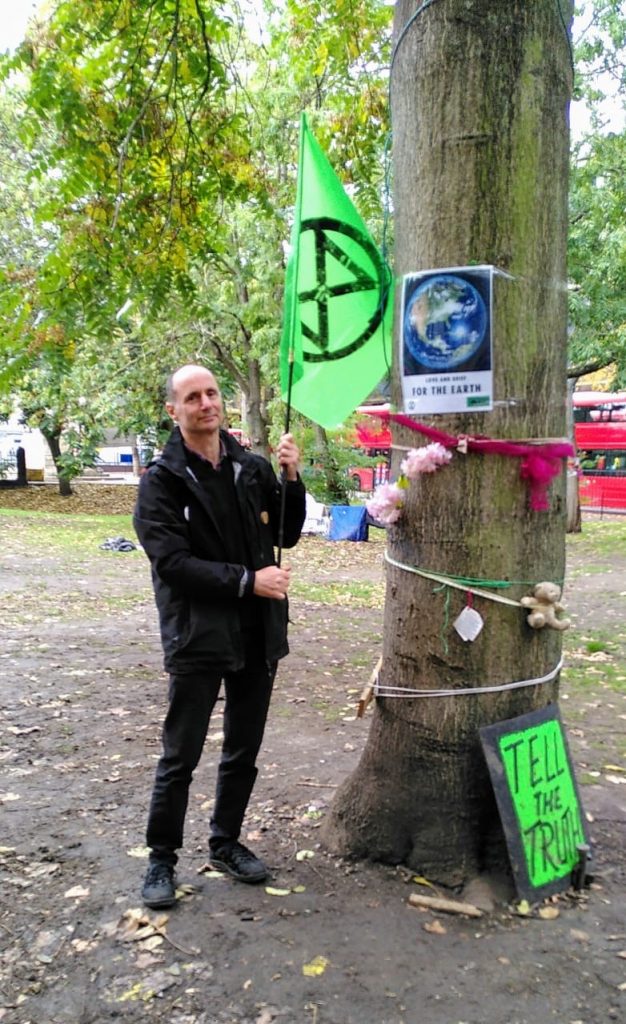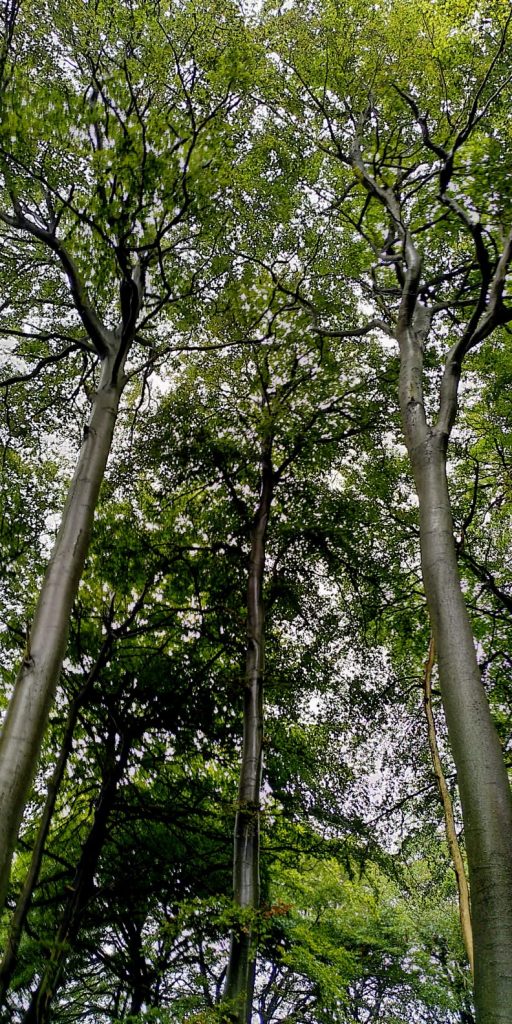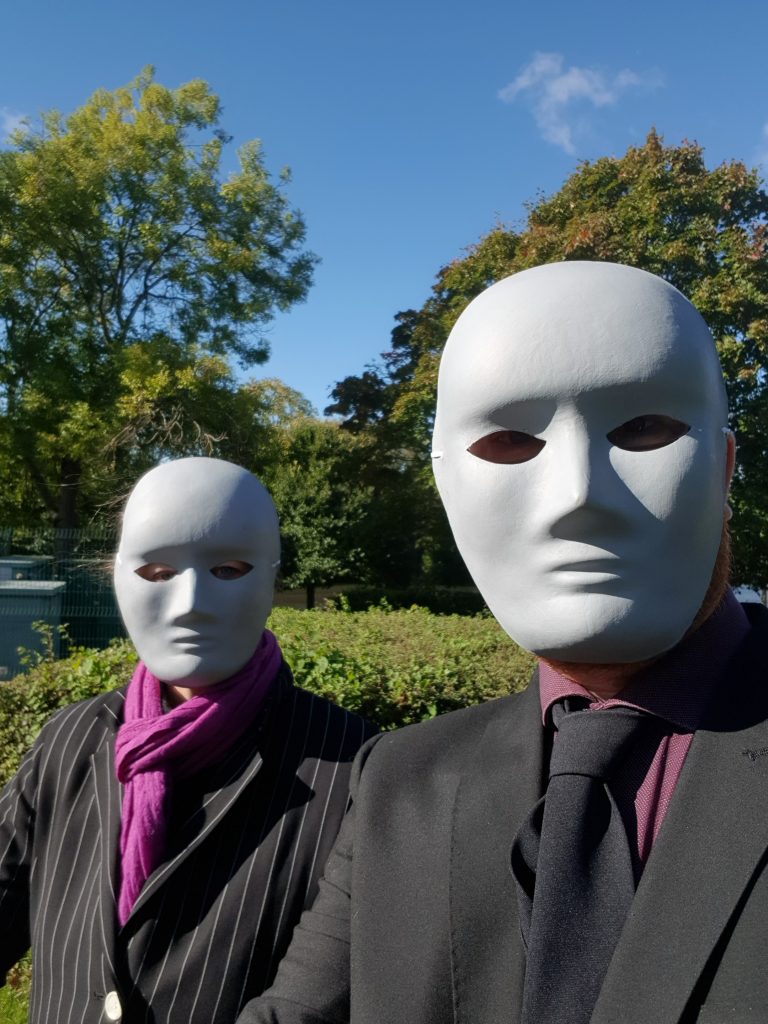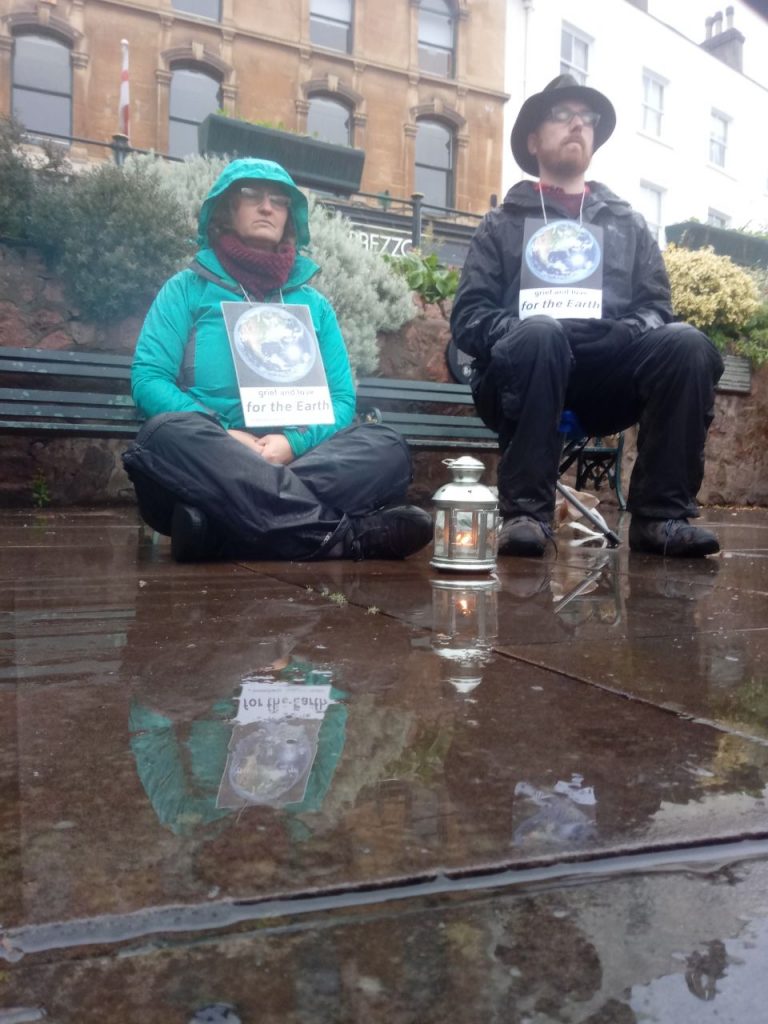Protest and spiritual practice
By Yogaratna

A lady dressed in green, with flowers in her hair, is holding a big blue planet Earth in her arms. She has a rope around her neck, and she’s being dragged through the streets of Cambridge (UK) by some scary-looking monster academics, complete with black gowns and mortar-boards — and very black hands. Dancers all in red are miming their grief. There’s a samba band, and a procession of people with banners and placards, many of them with black hands too.
It’s the Oily Hands Extinction Rebellion protest, drawing attention to the University of Cambridge’s long-standing refusal to take approximately £400m out of investments in fossil fuel extraction, and to sever its many links with the climate-wrecking fossil fuel industry.
I’m nervous. We’re right under the noses of many police. As we get near Trinity College (the College with the largest fossil fuel investments) I make sure I’m near the front of the procession. Suddenly I’m jumping over a low parapet and heading for the nearest part of the College, fumbling in my bag for the chalk-spray can. I put my left hand on Trinity College’s wall, and spray around it like a stencil, leaving an image of my hand just like people did in the Stone Age. I manage this 5 times, before feeling a gentle but firm grip round my arms, and a deep voice saying something about arrest.

9 of us were arrested and charged, mainly with ‘criminal damage’ — despite the fact we deliberately used chalk spray, which is very soluble in water, and the images were cleaned off almost immediately.

That was 28 August 2020 — near the end of a summer which had felt quite busy for me. I’d d-locked my neck to the main gate of the Schlumberger Research Centre (infrastructure support to the fossil fuel industry) for 4.5 hours. I’d mimed in an inflatable dinosaur suit (mocking Darwin College for failing to evolve and divest from fossil fuels). On a hot busy Saturday afternoon,along with 15 others, I had stood completely naked for 40 minutes outside Kings College (the Naked Truth about our vulnerability to climate and biodiversity breakdown). And so on.

Some Buddhists see this kind of activism as nothing to do with Buddhism. Some Buddhists feel that they do want to take direct action on these issues, but aren’t sure how to do that in ways appropriate to their spiritual practice.
I’m in the second category, but the question of how to respond appropriately is very live for me. I agree that the climate/natural world breakdown, and the global structural racism underpinning it, is a desperate emergency. I also agree with the XR emphasis on ordinary law-abiding people speaking out non-violently in many different ways, including disruptive actions risking arrest and imprisonment. But exactly how to speak out? How far to go? Is everything that is non-violent OK? And what is non-violence?
Starting from first principles, I think as Buddhists we need to respond in ways appropriate to what’s actually happening around us. When he came across the sick monk, the Buddha did not say to himself: I will benefit the world more if I spend the next hour teaching meditation and giving a Dharma talk. He himself cleaned up the sick monk — and then gave one of his most memorable teachings about responding to suffering. (Vinaya Pitaka, Mahavagga 8.26.1-8).
I’m not suggesting that Buddhists should do nothing but various kinds of social work and activism. Personally I do see activism as a crucial part of my spiritual practice, not the whole of it. But I think that things are so urgent today, that people of faith in particular need to speak out. And it’s important that we do that from as resourced and as skilful a place as possible. We need to go on retreat, to meditate, to do traditional Buddhist practices. But we need the life of activity, as well as the life of calm. We need to ground our practice in reality, to test the qualities and insights we develop, by challenging what is going on.
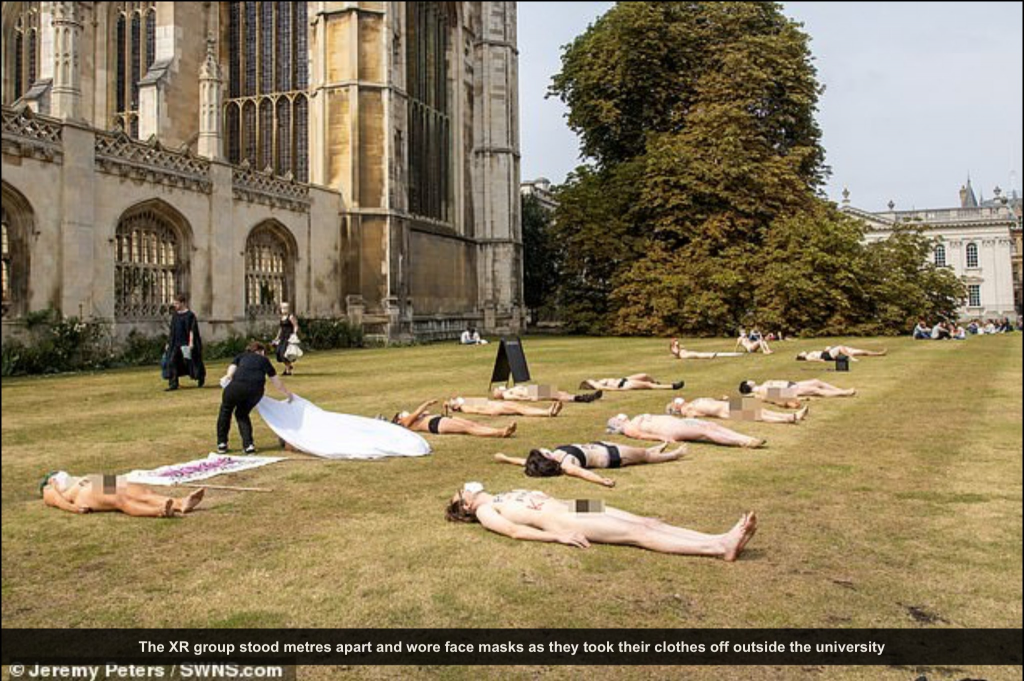
You might agree with all that in principle, but still question the efficacy, or even the ethics, of these slightly confrontational direct action tactics. And isn’t it all a bit undignified — even un-Buddhist?
Well. I do wonder if we sometimes get into a somewhat etherealized notion of Buddhism, or even the Buddha. The Buddha of the Pali Canon was on occasion perhaps surprisingly down-to-earth. At one point, for example, the Buddha criticised his cousin Devadatta in very forthright terms. He later argued that what might seem harsh speech was, in this very particular case, a lesser evil (Abhaya Sutta, Majjhima Nikaya 58). The wisest way of responding in that particular situation. The Buddha also spoke out against some of the most sensitive and tightly-held beliefs supporting the social power-structures of his day, including the caste system.
I wonder if sometimes we want to escape from samsara by turning our backs on samsara. Perhaps we just don’t want to get our hands dirty with the world’s problems. Some Buddhists of my kind of age-group (I’m 54) seem to see activism as a youthful phase they’ve long since grown out of. I’m just referring to negative tendencies we can all slip into. I accept that we all need to rest from engaging with the world’s problems from time to time (I do anyway) — and traditional practices can be vital spiritually. But majoring on them exclusively can also be a negative turning away from the world, a mask for inertia and fear.
I do accept that there can be serious ethical issues around direct action. People can be seriously inconvenienced, or even feel bullied, by roadblocks for example. People can feel personally attacked when an institution is criticised. But to me it seems like there is a fire, and we need to shout to get peoples’ attention. Shouting will annoy people, at least momentarily, but that really is a lesser evil compared to not raising the alarm.
The global response to the pandemic graphically demonstrates how most people have not got the message about climate and biodiversity breakdown, as well as the global structural racism that underpins it. Coronavirus has been front page news every day since March 2020, economies and businesses have been turned upside down, not to mention the ordinary lives of billions of people. But the breakdown of the Earth’s living systems is a far bigger problem, which calls for this kind of response as a bare minimum, and that is not happening anything like enough.
The Earth’s living systems, and issues of global justice, are talked about in contemporary politics, but with almost no positive results overall. So how do people’s worldviews change? How do important institutions change? There is some similarity with women in the UK 100 years ago being excluded from the political process. The mainstream ‘common sense’ view was that women should not have the vote, that women were not even capable of thinking politically. Does anyone think that women would have been given the vote, if they hadn’t spoken out, argued and campaigned for it?
Protest can make a difference. On 1 October 2020, the University of Cambridge announced that it would divest from all direct and indirect investments in fossil fuels by 2030 and cut its greenhouse gas emissions to net zero by 2038. That was after a five year campaign by Zero Carbon Cambridge, and many people. It’s hard to believe that change happens without people speaking up for it.
Having said all that, I don’t think that any tactics are justified. Of course we should be non-violent in the sense of not hurting people physically. But what about emotional non-violence? I think certain tactics, such as perhaps breaking things, can provoke so much revulsion that the tactic stops being a lesser evil and becomes counterproductive. There is a sweet spot: enough disruption to raise people’s awareness and hopefully lead to dialogue eventually, but not so much that people turn off and completely shut down. It’s a hard thing to assess. And the people causing the disruption will always be unpopular, all the more so when they’re bringing bad news.
In my own life I have been emphasising this more ‘spiky/spicy’ end of activism, risking arrest and so on. But that hasn’t always been and (I hope) won’t always be the case. Useful and meaningful resistance is a wide spectrum, which for me definitely includes all Buddhist practices. Writing letters, holding up banners, theatre, music, going on marches and so on can all be effective ways of making a point or getting dialogue going. There are myriad ways of doing activism, or supporting it. Some of the best activism might be trying to skilfully talk about these issues with anyone we know personally.
Whatever form of speaking out, resistance, activism is right for you — I wish you well with it.
Can activism be a real spiritual practice?
I think what is spiritual practice will be different for every person. But here are some thoughts about my own experience. I think activism has helped me develop deeper metta, equanimity and even insight. I notice that I generally feel much less angry about these issues than I did when I first got really concerned about climate breakdown back in 2006. And I’m glad not to be so angry! Anger can be a positive energy for me, but can also take me into tiredness and depression — especially if the news isn’t good. I’ve had to really reflect on my own views and states of mind. I’ve encountered people with opinions and worldviews diametrically opposite to mine, or just different to mine. Like many activists, I’ve been shouted at, criticised in the local press and on social media, and physically assaulted. I’ve done a lot of reflecting on the conditionality of those people, on mine, on the impermanence of everyone and everything I love — including the beauty and impermanence of the natural world itself.
So I’ve been trying to help preserve what I love, whilst also trying to accept that there will not be a happy ending, almost certainly there will be a great deal of human suffering and destruction of the natural world.
The situation has almost forced me to move towards my fears. I’m not just afraid of what will happen to the world, myself and people I love in the future. I also just feel afraid of speaking out, of being seen as wrong or even criminal — afraid even of being seen.
I think under the pressure of my ongoing activism my Buddhist practice has helped me let go of my negative emotions, such as fear and anger — to some extent! And I’ve been almost forced to clarify: what do I really think, what are my values, what do I really care about? I’ve been almost forced to look after my heart, to nourish and connect with my spiritual inspiration — a deeper energy.
And my heart has opened, keeps opening more, to the power of sangha. The extraordinary beauty of other people’s idealism, which inspires and sustains me.
There are many ways of practising, many ways of doing activism, and there can be a grittier side. At the time of writing this, I’ve been charged with criminal damage (for chalk spraying on a wall). I’ll be self-representing at my trial in a few months time. I’m pleading not guilty, but will probably be convicted and have to pay a fine, compensation and court costs, possibly have to do community service, and the prosecution is seeking a Criminal Banning Order. In the longer term, I will have a criminal record and that might threaten my job as a carer. And I am surprised at how much this one case is affecting me (and my partner). Partly I find there’s a sort of emotional weight to the whole thing of being called a criminal.
Now, all that might sound a bit daunting, and there are limits to what I’m happy to give. But I’ve almost no regrets so far, and this still feels the right direction for me. It’s how I feel free, richer, happier, and more authentically myself. I do actually feel like I have been touching the Earth more — coming into a closer relationship with reality both internally and externally. In the end, I need to speak out somehow.
Protest and spiritual practice Read More »

